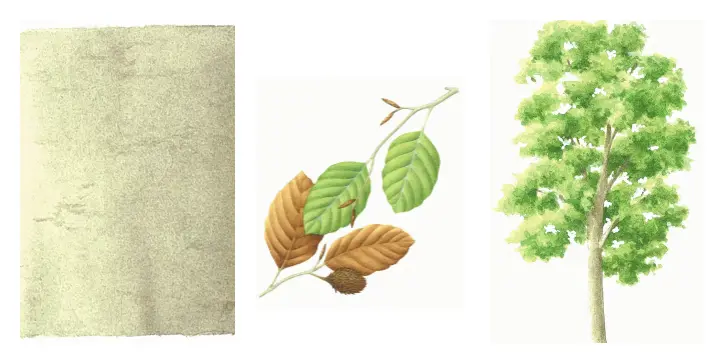Beech
Beech

There is some current discussion about whether beech – or Fagus sylvatica in Latin – would naturally have reached Scotland by now from post glacial populations in Southern England. Whilst its native status is still open to question, Forestry and Land Scotland is keen to use this species where it will meet our objectives such as creating beautiful landscapes and providing hard wood timber. However, we will avoid planting beech in or near ancient woodlands that are not adapted to its shade. Beech is particularly damaging in western locations where it could invade temperate rainforest and pose a substantial threat to rare lichens and bryophytes.
In Scotland, you’ll find several beech trees of note dotted across the central belt. This deciduous species favours chalk downlands, but can also grow well on light soils, and its dense shade usually keeps the forest floor clear of undergrowth.
Facts and stats
- Lifespan: 350 years.
- Height: Beech can grow to 40 metres. Mature trees have a dense canopy made up of many branches.
- Leaves: Green in spring and summer, turning first to yellow then to bronze in autumn.
- Seeds: The husks split to release two triangular seeds, 'nuts' or 'mast' and can be eaten. The French roast them to make a type of coffee.
- Bark: Smooth, grey and delicate – making it a popular tree for lovers to carve their initials into.
- Insect species it supports: 98
- Native to: Europe, but not Scandinavia
- Uses: Beech wood is easily turned, fine-grained and knot-free, making it ideal for furniture making. In the past the wood was used for rifle butts, brush backs and for making shoe heels and lasts.
Famous beech trees in Scotland
Act of Union beech trees
On the short walk up North Berwick Law, in East Lothian, sits a handful of gnarled, windblasted trees. These are all that remains of a woodland planted by local laird, Sir Hew Dalrymple, to signify the union of the Scottish and English parliaments in 1707.
Old Maggie
This imposing copper beech sits proudly in the grounds of Belmont Castle in Perthshire. She was named by former Prime Minister, Henry Campbell-Bannerman, who enjoyed sitting in her shade, mulling over his policies.
The Gallows Tree
Atop a lonely hill near Monikie village in Angus, sits this sinisterly named beech. Wrongdoers met their ghoulish end swinging from the branches of the Gallows Tree – a highly visible forewarning to any would-be criminals in the surrounding area.
The Kilravock Castle kissing beech
An extremely rare example of a 'layering beech' can be found at Kilravock Castle, near Nairn. A layering beech is characterised by its octopus-like limbs, some of which take root in the ground and form further small trees. This particular tree has romantic roots too. It is fabled that an early landowner was caught in a tryst with the housemaid under this beech. Since then, generations of lovers have etched their initials into the bark.
Lady Miller’s beech
Named after the colourful landlady of a local tavern, whose secret sideline was an illicit still from which illegal alcohol was smuggled into nearby Perth.
The Meikleour beech hedge
Take a leisurely drive down the A93 and witness the wonder of the world’s tallest hedge, which stands at an impressive 30 metres tall.
The Pollok Park beech
It’s the trunk of this beech that makes it quite remarkable. The huge distorted mass of burs and branches is up to seven metres wide in some places. Find it in the gardens of Glasgow’s Pollok House.
The Seven Men of Moidart
Standing in private land on the northern shore of Loch Moidart, these five trees (once seven) were planted to commemorate the men who landed with Bonnie Prince Charlie at Glenfinnan in 1745.